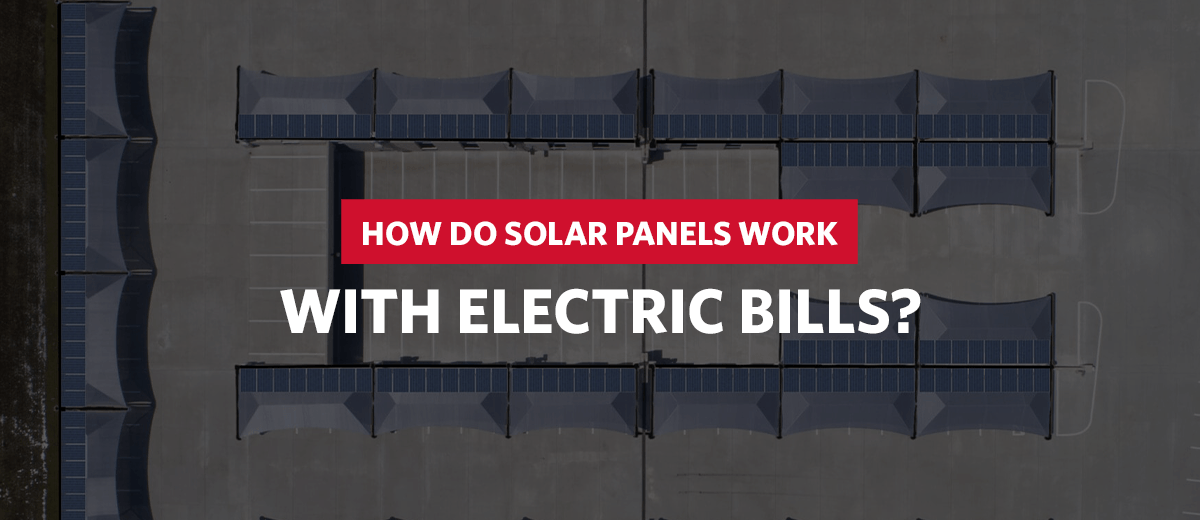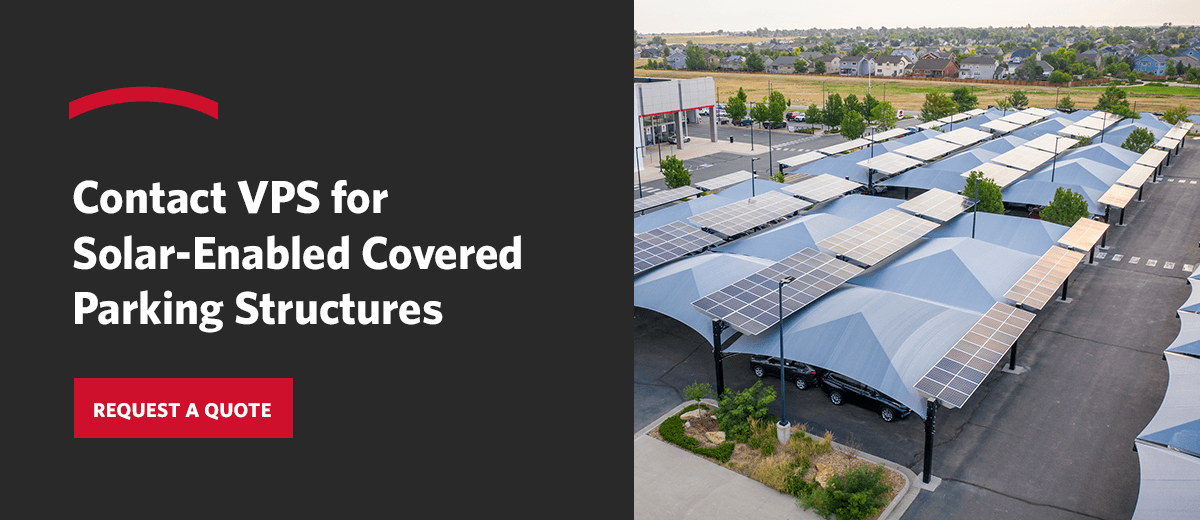Overall, solar panels can significantly reduce electricity consumption, reducing reliance on traditional power sources like nuclear energy, coal, or natural gas. Many organizations make the switch to solar to save on overheads, but it is essential to understand exactly how that investment impacts utility bills. There is still an electric bill with solar panels, and organizations should understand how
Understanding Solar Panels and Electric Bills
Understanding how solar panels affect electric bills starts with the relationship between energy production and consumption. This insight is the first step in justifying a potential investment in solar power for a business. Put simply, solar panels generate electricity used to power buildings or equipment, reducing the need to draw energy from the grid.
The Basics of Solar Power
Solar panels generate electricity through a photovoltaic (PV) conversion process, converting sunlight into electrical energy. Each solar panel consists of numerous PV cells, typically made of silicon, that absorb photons from sunlight. When the photons hit the PV cells, they knock electrons loose from the atoms in the silicon material, creating an electric field that forces the electrons to flow in a specific direction. This process produces direct current electricity, which is then turned into alternating current power.
The amount of electricity generated via solar panels depends on:
- Panel efficiency
- Sunlight intensity
- Panel angle and location
The Role of Electric Bills in Solar Installations
Businesses still have an electric bill with solar panels, regardless of the amount of new clean energy production. The difference is that the bill’s balance will be significantly lower, perhaps even negative, depending on how much the solar energy offsets the grid electricity. Electric bills will indicate a payment due when there is a shortfall of solar power, causing the business to switch to grid use. Should the monthly solar power generation meet or exceed the business’s needs, the bill will reflect as such.
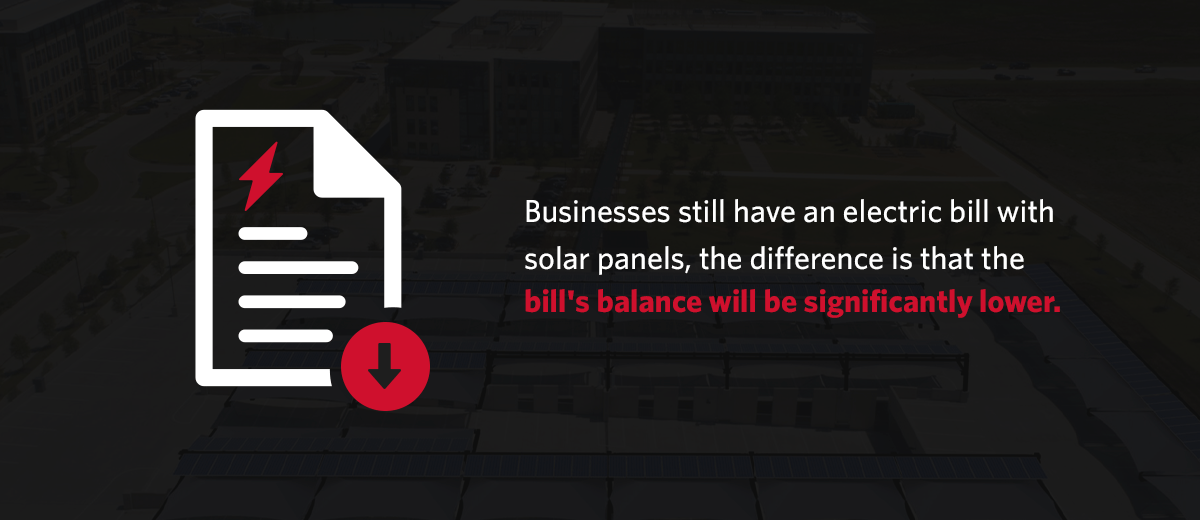
Net Metering and Solar Power
If a solar power system produces more energy than is consumed on-site, the surplus energy will be returned to the grid, and under a Solar Power Purchase Agreement, the utility company may compensate the customer. Net metering facilitates this credit to solar system owners and encourages commercial solar power adoption.
What Is Net Metering?
Net metering allows solar energy owners to receive credits for the potential excess electricity they may generate and send back to the grid. This process is essential for distributed generation and improves the consumer’s return on investment (ROI).
Net metering policies vary by state and utility, impacting the following:
- Compensation rates: Businesses may receive retail-rate credits for their excess energy. Some states offer avoided-cost rates, which are lower than retail.
- Credit rollovers: Many net metering programs allow energy credit rollovers, which can be used in future billing cycles.
- Demand charges: For large-scale commercial customers, demand charges based on peak energy usage can represent a significant portion of the bill.
- System size limitations: Some net metering programs cap the size of the eligible solar energy system, usually based on a percentage of the business’s peak demand or total energy usage. Exceeding the limit may reduce financial benefits.
Calculating the Impact of Net Metering on Bills
An average of 20%-40% of a solar system’s output can return to the grid to serve other customer loads. Several factors must be considered to determine the impact net metering has on a business’s energy bills.
First, the calculation should consider energy consumption versus solar production. Businesses must assess their energy consumption patterns to compare them with the solar energy system’s output. While surplus energy is credited back to the company, energy deficits, which happen when consumption exceeds production, are charged at the standard utility rate.
The net energy metering billing structure credits surplus power generation per kilowatt-hour (kWh) using net excess generation (NEG). Credits are typically applied to future billing periods, lowering costs during higher energy demand or lower solar production.
To calculate the total utility bill:
- Calculate the energy used and solar power produced during the billing period. Subtract the total consumption from the generated power to determine the deficit or surplus.
- If there is surplus energy, apply the utility net metering rate to the credit.
- If there are deficits, calculate the amount of energy purchased from the grid and apply the standard electricity rate.
- Adjust the final bill by applying credits carrying over from any previous billing cycles.
It is essential to consider fixed and demand charges, which net metering does not typically reduce.
Here’s an example:
- Monthly solar generation: 10,000 kWh
- Monthly consumption: 8,000 kWh
- Surplus generation: 2,000 kWh
- Utility rate: $0.12/kWh
- Net metering surplus credit: 2,000 kWh x $0.12 = $240 credit
If the business’s monthly energy bill is $960, the new bill is reduced by a $240 credit, resulting in a final bill of $720.
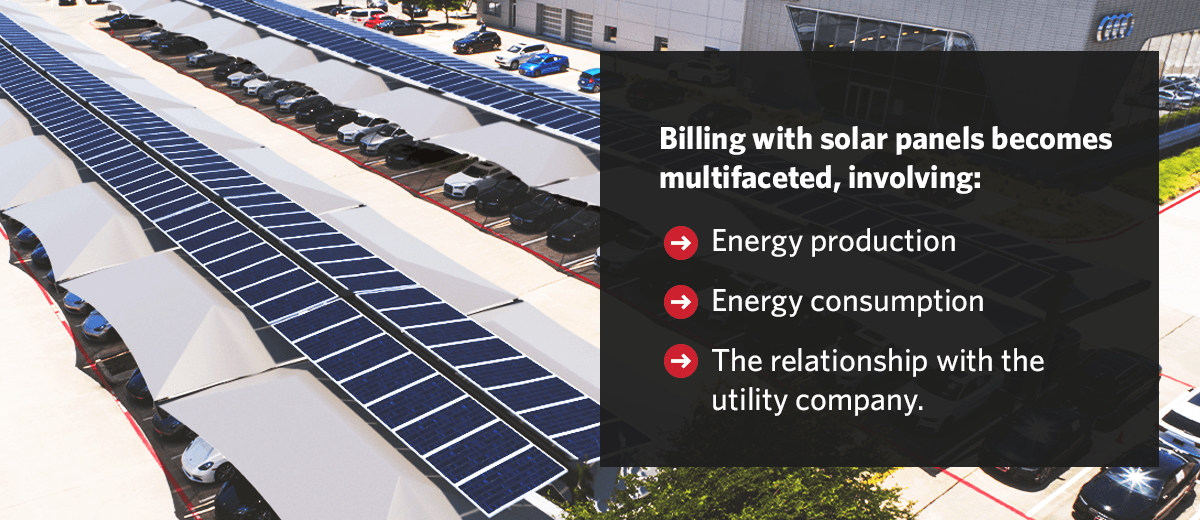
How Billing Works With Solar Panels
With solar panels installed, billing becomes multifaceted, involving energy production, energy consumption, and the relationship with the utility company.
Utility bills for solar panel users generally include these key components:
- Energy charges: Energy charges are the costs for the electricity drawn from the grid, charged per kWh.
- Delivery and transmission charges: Customers connect to a utility grid even when using solar panels. Depending on whether or not grid power is consumed, utilities may charge fixed fees for infrastructure maintenance.
- Surplus credits: Any excess energy exported to the grid may earn credits or compensation.
Understanding Solar Electricity Bills
Customers using time-of-use billing plans may see varying electricity costs depending on the time of day. When demand is high during peak hours, electricity is more expensive. Solar panel owners can strategically use electricity during off-peak times while relying on their own solar generation during peak hours to maximize savings.
Some solar installations include batteries that store excess power for use at night or during high-demand periods. This concept is known as energy arbitrage. Billing in these cases reflects both the reduction in grid dependency and potential savings from avoiding peak-rate electricity purchases.
In some regions, utilities have minimum bill provisions, ensuring even solar system customers pay a monthly baseline amount. It contributes to the grid’s infrastructure upkeep.
In some cases, utility companies may do an annual reconciliation. This process compares total energy consumption against total solar generation throughout the year, adjusting the account for remaining credits or charges. Following this period, the utility may:
- Apply credits to future bills if there is excess power generation.
- Issue a refund for surplus solar power at a predetermined rate.
- Charge for shortfall where grid consumption exceeded solar production.
How to Manage Solar Power Excess
Managing excess solar power involves several operations that determine how the surplus energy is handled, as well as the potential outcomes:
- Storage: Excess solar power can be stored in battery systems for later use when solar production is low, such as during cloudy periods or at night.
- Grid export: Surplus energy is often sent back to the electrical grid, with financial compensation that varies by utility policies and region.
- Curtailment: Some surplus energy may be wasted if the system has no storage or grid export options. Potential savings are lost, as the generated energy generates no revenue and offsets no electricity costs.
- Energy arbitrage: Using excess stored energy during peak times allows businesses to avoid high energy costs, reducing operational overheads.
Excess solar power can impact a facility’s bottom line in multiple ways. By storing surplus power, businesses can reduce their dependence on the grid and lower overall energy costs. Excess energy exported to the grid can generate financial compensation through direct payments or bill credits.
Managing additional power through grid integration or storage may need additional infrastructure investments, such as more sophisticated energy management systems or larger batteries. These upfront costs can eventually improve an organization’s long-term savings.
However, local utility agreements and policies can influence the financial benefits of managing surplus solar energy, affecting the compensation rate for exported energy and applicable grid connection fees.
How to Handle Insufficient Solar Power
A range of strategies can help ensure a business’s continued energy supply and minimize the financial and operational implications of insufficient solar generation.
Implications of Insufficient Solar Production
Insufficient solar power increases grid dependency periods and the accompanying energy costs, especially during peak usage times. It raises utility bills with higher demand charges. In extreme cases, insufficient solar power can affect energy-reliant operations, especially if alternative energy sources are unavailable. It also means higher reliance on fossil-fuel-generated electricity, which reduces the environmental benefits of using solar power.
Strategies to Mitigate Insufficient Solar Power
Other than battery storage, businesses can combine solar power with other renewable energy sources, like wind or hydroelectric, to create a hybrid energy system.
Implementing an advanced energy management system (EMS) also allows for better optimization and energy use tracking. EMS monitors energy demand in real time, assisting with moving nonessential loads to off-peak times. These systems can also use stored energy when solar generation is slow to ensure resources are used more efficiently.
Load shedding shifts noncritical loads, reducing them or turning the power off during periods of insufficient solar power. Alternatively, a demand response program, which utilities often offer, provides financial incentives to reduce energy use during peak times.
Businesses can also enhance overall energy efficiency, reducing total energy demand and lessening reliance on solar and grid power. Techniques include:
- Switching to energy-efficient appliances
- Upgrading insulation
- Using LED lighting to lower base demand
Making sure the solar system performs optimally also mitigates the risk of insufficient solar power. Regular maintenance and monitoring systems can help detect inverter inefficiencies or shading issues, which may reduce output. Keeping the system in top condition can minimize the risk of insufficient solar production.
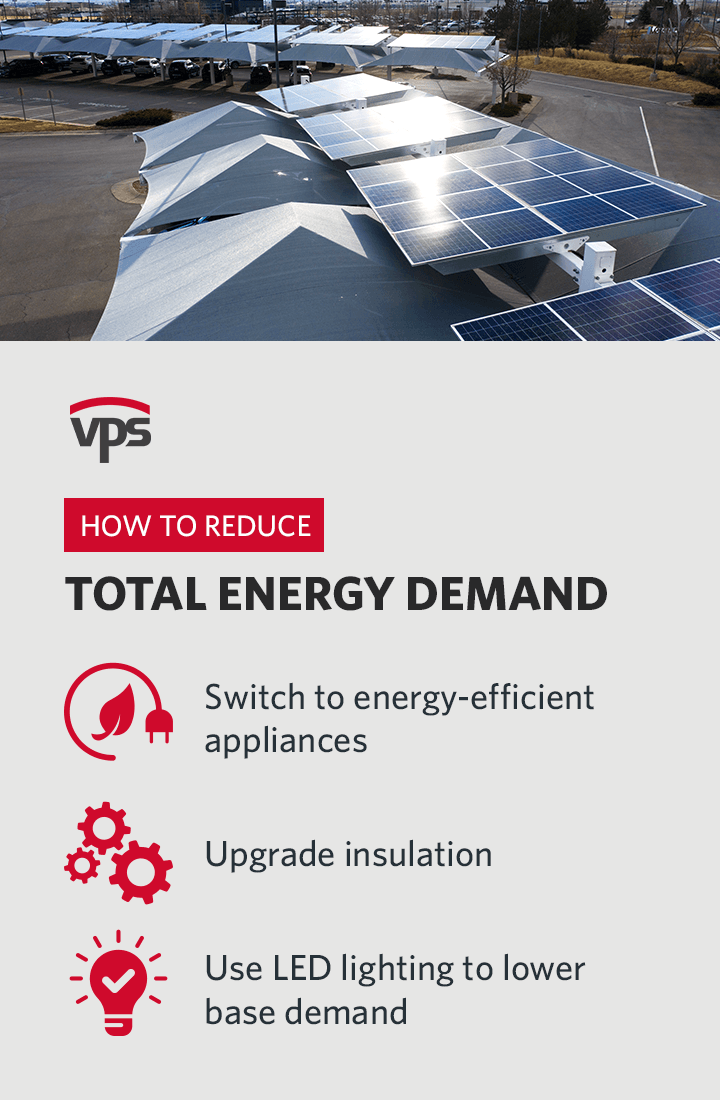
Frequently Asked Questions
Solar systems and electric billing can seem complex, as businesses still receive an electricity bill with solar panels. However, with proper solar power management and the exploration of various installation options, businesses can increase their off-grid stance. These FAQs can provide more clarity on common questions about managing energy production and incentives to switch to solar:
Can Microgrids Help During Low Solar Power Periods?
A microgrid system is a localized energy grid that can disconnect from the traditional grid and operate autonomously to help manage insufficient solar power. It integrates various energy sources and storage to ensure energy stability and cost control.
What Incentives or Tax Credits Are Available for Commercial Solar Installations?
There are two types of tax credits available for businesses. The first is the investment tax credit, which allows qualifying organizations to potentially lower their federal income tax. The second is the production tax credit, which lowers federal income tax liability depending on solar energy production.
Is System Oversizing Necessary?
System oversizing and installing a solar system that exceeds the typical energy demand may help with power consistency during low-solar periods. Oversizing allows facilities to generate more energy during favorable conditions, exporting or storing the surplus. It creates a buffer during less optimal periods.
Where Is the Best Place to Install Solar Panels for a Business?
Commercial properties have many options regarding solar panel placement. The most common choice is to install the panels on the building roofs. However, business owners can also add solar panels in open spaces, such as large fields that have no other uses.
Solar-covered parking resources protect on-site structures while optimizing energy use, especially for operations such as municipalities, distribution centers, sports facilities, airports, and car rental facilities. These panels can also come with hail protection to protect various valuable assets from the elements.
Contact VPS for Solar-Enabled Covered Parking Structures
Billing with solar panels involves solar generation, energy consumption, and grid dependency. While self-consumption reduces electricity costs, charges for grid power, demand rates, and fixed utility fees continue to apply. Solar panels can be integrated into various businesses, from commercial parking lots to OEM facilities and auto dealerships.
VPS is a global leader in supplying commercial parking products and solutions, helping maximize space and enabling energy independence. VPS represents over 95% of all global automotive hail protection and offers turnkey solutions that include conceptual design, manufacturing, project management, construction, and post-sales support.
Contact us today for a free quote on solar-covered parking solutions and start enjoying the benefits of a long-term return on investment.
